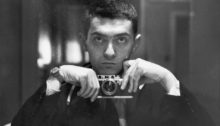
These notes were generated after seeing the catalogue of a major exhibition currently on at the Museum of New York City called Through a Different Lens: Stanley Kubrick Photographs. It shows the young Kubrick’s expert eye in about 300 photographs, most from his precocious days as a Look photographer when he joined the staff at 17. They range from social realism to, yes, voyeurism in a film noir style. A Different Eye may have been a more apropos title, but that’s nit-picking a brilliant event. These images foreshadow all of Kubrick’s movies, sometimes in your face.
A photo of a full length nude model from the back view, as ribald New Yorker cartoonist Peter Arno studies her, startlingly precedes the nude shot of Nicole Kidman at the beginning of Eyes Wide Shut by about fifty years. The viewer becomes the voyeur watching the voyeur in this photo. Clearly Kubrick’s interest in female anatomy never waned. He follows here in the libido-centric footsteps of Picasso, Renoir and many other masters. Ever a humanist and an unprejudiced artist, an arguably homoerotic photo of nude boxer Rocky Graziano showering equalizes the gender eroticism, making the point that Kubrick can’t be accused of exploitation of women. Later the long shot of the gang handling a naked woman in A Clockwork Orange (1971) momentarily veered in an unwholesome pornographic direction, but one suspects Kubrick was letting loose with the relaxing censorship of the Sixties. Hitchcock also let loose in the graphic murder scene in Frenzy (1972). Adieu the Lubitsch touch as Kubrick and Hitchcock pushed the envelope hard, and didn’t bother to put a stamp on it. Years of artistic repression suddenly disappeared in controversial eruptions.
Still, in more demure times Kubrick’s Brassai-style images of lovers in the city have a faintly voyeuristic feel suitable for all ages. A photographer is a kind of voyeur by definition, but not necessarily of the sexual variety, although historically sex as a subject seems to drive most art. That is why the Mona Lisa is smiling, in my opinion. After all, some now suggest she was a he.

Back to Kubrick. The black comedy of Lolita sends up voyeurism with a vengeance. Creepy James Mason perving on teenage Lolita makes us all squeamish pervs for a moment. This escalates with the arrival of Peter Sellers as Quilty, in many ways the penultimate voyeur in film. This cringe-inducing character makes you want to escape the cinema, but you are held back by how bloody funny he is. Sellers and Kubrick extrapolated this person into Dr. Strangelove, with his uber voyeuristic suggestion that humanity can be saved by an underground bunker in which there would be ten women to every man. Sellers’ indescribable smiles in both Kubrick films reek of bizarre, raunchy voyeurism: like a Carry On film directed by Ingmar Bergman.
Kubrick competes with Hitchcock as cinematic voyeur in chief. In fact, one could argue that HAL in 2001, with his all-seeing huge eye, is the ultimate voyeur in the history of film. He watches everything with an agenda. Kubrick ultimately has to kill him, and when HAL sings Mary Had A Little Lamb in his death throes, one senses perhaps it’s the death of a paedophile voyeur, albeit a digital one.
Any astute culturally literate person will understand the link between an artist and a voyeur. Voyeurism may be an essential arrow in the artist’s quiver. Studying at least four hundred years of exquisitely painted reclining nudes is a good start to appreciating this.
Sometimes they are not reclining, and often these voyeuristic images shocked the bores of their era. Courbet, Manet, Velasquez, Gauguin, Picasso, Bacon and many more used nudity to push our understanding of reality and society forward. Dali famously told a female nude model not to look at his painting until it was finished. Taking a break after three hours he went to the bathroom. The model peaked at the canvas. It was blank. One can imagine this as a scene in a never-made Kubrick film starring Sellers.
The snickering classes usually understand a revolutionary work decades if not generations later. Picasso blew minds with Les Demoiselles D’Avignon (1907), a painting of five nudes in a Barcelona brothel. Brutalizing the images into almost satirical sexual form he simultaneously mocked the gentle or aesthetic voyeurism of a Degas, Renoir or Ingres. He was a voyeur with a loudspeaker. The painting triggered Modern art as we know it today.

In the sense that a film director has to study human behaviour very closely to reproduce it later with actors, he can be an enthusiastic voyeur. Some directors even make this the very subject of their films. Michael Powell’s Peeping Tom is a telling example. Hitchcock makes a masterpiece of voyeurism with Rear Window. He illustrates and polishes the really dark side of voyeurism in Psycho and Frenzy. The shower scene in Psycho is the bleakest voyeuristic scene until HAL in 2001 intones: Sorry Dave I can’t do that. Kubrick, Hitchcock and Powell make us all accidental voyeurs and that’s also interesting. Is a filmgoer a voyeur? Are museums showing masterpieces of male and female nudity also havens for voyeurs, turning us all into peeping toms?
A personal meta note: I curated with Sigi Kraus a wild show in his gallery in London in 1970. It included a huge penis sculpture and dancing Christ sculptures by Ron Shamask; a film about the Crucifixion I made, and a sculpture made of meat. It all caused a public scandal. Someone from Kubrick’s team visited the exhibition and the penis and the dancing Christs ended up in A Clockwork Orange. Malcolm McDowell chases Miriam Karlin around with the penis sculpture from the show. Is that scene voyeurism, or a parody of voyeurism? I’ve stopped worrying.

Comments
One response to “Notes on Stanley Kubrick: Filmmaker, Artist, Voyeur”
Always good to see mention of the superb ‘Peeping Tom’.
Thanks for a very interesting article, Philippe.
Best wishes, Pete.